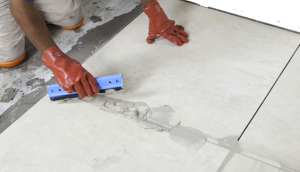When it comes to sourcing a flooring option that will last the test of time, floor tiles are the unsung heroes of the home improvement industry. With a range of shapes, sizes and colors, they are a practical and affordable flooring solution for any room in the house. Most floor tiles in South-Africa can be used as wall tiles as well.
Whether you’re looking to give your kitchen a modern face lift or brighten up a living room, floor tiles offer versatility and durability that other flooring materials just can’t beat. From porcelain tiles to ceramic tiles and porcelain mosaic tiles, there’s a floor tile option to suit every aesthetic, budget and lifestyle.
What’s more, the benefits of floor tiles don’t stop there. Their ease of installation, low maintenance requirements and easy cleaning make them the ideal choice for busy household owners. Floor tiles are also incredibly cost-effective, making them an attractive option for those looking to upgrade their home without breaking the bank.
Yet, while the advantages of floor tiles are clear, it can be overwhelming to navigate the many options available in today’s market. In this blog post, we uncover the key to unlocking the best durable and cost-effective flooring solutions to suit your needs and personal style. We provide an in-depth review of the various types of floor tiles and their respective benefits, alongside tips and tricks to ensure the tile installation process is as easy as possible.
Ready to learn more? Read on to discover how floor tiles can transform the look and feel of your space.
Advantages of Floor Tiles
Advantages, Durability, Cost-effectiveness, Versatility
Floor tiles are a popular and versatile option for flooring surfaces in residential and commercial spaces. Whether you’re planning to install new floors in a home or business space, floor tiles can provide a number of advantages.
Tiles are cost-effective. Floor tiles are available in a variety of materials like ceramic, porcelain, and stone, so you can choose one that fits your budget. Floor tiles are also easy to install and maintain.
Floor tiles are also incredibly versatile. They can be used in any room or space, and they come in a variety of colors and designs so you can find the perfect one to match your decor. Floor tiles can be used to create unique patterns and designs, making them a great choice for customizing any room or space.
In conclusion, floor tiles offer a number of advantages. They are durable, cost-effective, and versatile, making them an ideal choice for any residential or commercial space. Whether you’re looking for a timeless classic or something more modern, floor tiles offer a number of options to suit any style.
Different Types of Floor Tiles
There are many different types of floor tiles available on the market today. Here are a few of the most common types:
Ceramic tiles: These are a popular choice for bathroom and kitchen floors, as they are durable and easy to clean.
Porcelain tiles: Similar to ceramic tiles, porcelain tiles are also very durable and depending on the profile can be tiled up to 3mm when rectified.
Wood-look tiles: These tiles mimic the look of hardwood floors but are made of materials like porcelain or ceramic.
How to Choose the Right Floor Tiles
Choosing the right floor tiles can greatly impact the overall aesthetic and functionality of a space. Here are some factors to consider when selecting floor tiles:
Purpose and Location: Determine the purpose of the space where the tiles will be installed. Different areas of a home or commercial space have different requirements. For example, the tiles in a bathroom or kitchen should be easy to clean, while tiles in a living room or bedroom can prioritize aesthetics and comfort.
Durability: Consider the durability of the tiles based on the amount of foot traffic the area will experience. High-traffic areas such as entryways, hallways, and commercial spaces may require more durable tiles that can withstand heavy use.
Style and Design: Choose tiles that complement the overall style and design of the room. Consider the color scheme, patterns, and textures that will harmonize with the existing or planned decor. Remember that trends change, so opt for timeless designs if you are looking for a long-term solution.
Size and Shape: Tile size and shape can have a significant impact on the visual perception of a space. Larger tiles can create an illusion of a larger area, while smaller tiles can add intricate details and patterns. Consider the scale of the room and choose tile sizes and shapes accordingly.
Material: Tiles are available in various materials, each with its own characteristics. Some common options include ceramic, porcelain, slate, etc. Research the pros and cons of each material, considering factors like durability, maintenance requirements, and cost.
Maintenance: Different tiles require different levels of maintenance. Some materials may require regular polishing, or specific cleaning agents. Consider the amount of time and effort you are willing to invest in tile maintenance and choose accordingly.
Budget: Set a budget for your tile selection and explore options within that range. Tiles can vary significantly in price based on the material, size, and brand. Remember to consider the cost of installation and any additional materials required, such as adhesives or grout.
Samples and Visualize: Obtain tile samples whenever possible to see how they look in your space. This will give you a better idea of how the color, texture, and pattern will work in your environment.
Professional Advice: If you’re unsure about the selection process or have specific requirements, consult with us on your project. Our sales team can provide expert advice based on their knowledge and experience.
By considering these factors, you can make an informed decision and choose the right floor tiles that meet your functional needs, aesthetic preferences, and budgetary constraints.
Tips for Installing Floor Tiles
Installing floor tiles can be a rewarding project that can enhance the appearance and functionality of your space. Here are some tips to help you with the installation process:
Plan and prepare:
Measure the area accurately to determine the amount of tiles and materials you will need.
Choose the type and size of tiles that suit your preferences and the room’s requirements.
Prepare the sub floor by ensuring it is clean, level, and free of any debris or unevenness.
Gather the necessary tools and materials:
Tile adhesive or mortar
Trowel for applying adhesive
Tile spacers to maintain consistent spacing between tiles
Tile cutter or wet saw to cut tiles
Grout and grout float
Sponge or cloth for grout cleanup
Level, measuring tape, and chalk lines for accurate placement
Start with a dry layout:
Lay out the tiles without adhesive to see how they fit in the space. This helps you plan the layout and make any necessary adjustments before committing to adhesive.
Follow a pattern:
Choose a tile laying pattern such as diagonal, herringbone, or straight. Ensure that the pattern is consistent and visually appealing across the entire floor.
Apply adhesive:
Mix the adhesive or mortar according to the manufacturer’s instructions.
Begin in one corner of the room and use a trowel to spread the adhesive evenly, working in small sections at a time.
Lay the tiles:
Place the tiles gently into the adhesive, pressing them down firmly and evenly. Use tile spacers to maintain consistent spacing between tiles.
Cut and fit tiles:
Measure and mark tiles that need to be cut to fit around the edges or obstacles in the room.
Use a tile cutter or wet saw to make the necessary cuts, following safety guidelines.
Allow for proper drying time:
Follow the adhesive manufacturer’s instructions for drying time before proceeding to grouting. It typically takes 24 to 48 hours.
Grouting:
Mix the grout according to the manufacturer’s instructions.
Use a grout float to apply the grout diagonally across the tiles, ensuring it fills the gaps completely.
Clean up:
After a short drying period, use a damp sponge or cloth to wipe away excess grout from the tiles.
Follow the grout manufacturer’s instructions for curing time.
Finishing touches:
Remember to always refer to the specific instructions provided by the tile and adhesive manufacturers, as they may have specific guidelines and recommendations for their products. Additionally, consider safety precautions such as wearing protective goggles and gloves when working with tile cutters and adhesives.
Maintenance and Care for Floor Tiles
Proper maintenance and care for floor tiles are essential to ensure their longevity and keep them looking their best. Here are some guidelines to follow:
- Regular cleaning: Sweep or vacuum the floor tiles regularly to remove dirt, dust, and debris. This prevents them from scratching the surface of the tiles when walked upon.
- Mopping: Depending on the type of floor tiles, you can mop them with warm water and a mild detergent. Avoid using harsh chemicals or abrasive cleaners as they can damage the tiles. For stubborn stains, use a non-abrasive cleaning solution specifically formulated for tiles
- Grout cleaning: The grout lines between the tiles require special attention. Regularly clean the grout lines using a mixture of baking soda and water or a mild grout cleaner. Scrub the grout gently with a soft brush to remove any dirt or stains. Avoid using abrasive materials that can scratch or erode the grout.
- Stain prevention: Wipe up spills immediately to prevent stains from setting into the tiles or grout. Certain substances like red wine, oil, or acidic liquids can cause permanent staining if not cleaned promptly.
- Avoid abrasive materials: Do not use abrasive tools or harsh cleaning pads that can scratch or damage the surface of the tiles. Stick to soft microfiber cloths or non-abrasive sponges for cleaning.
- Use doormats: Place doormats at the entrance of your home or any high-traffic areas to prevent dirt and grit from being tracked onto the tiles. This reduces the risk of scratching and keeps the floor cleaner.
- Furniture protection: Place protective pads or felt sliders under the legs of furniture to prevent them from scratching or damaging the tiles when moved.
- Avoid excessive moisture: Standing water or excessive moisture can seep into the grout lines and cause damage over time. Wipe up spills promptly and ensure proper ventilation in areas prone to moisture, such as bathrooms and kitchens.
- Regular inspections: Periodically inspect the tiles for any cracks, chips, or loose tiles. Address any issues promptly to prevent further damage and to maintain the integrity of the floor.
Remember to always refer to the manufacturer’s guidelines and recommendations for specific care instructions, as different types of floor tiles may have unique requirements.


